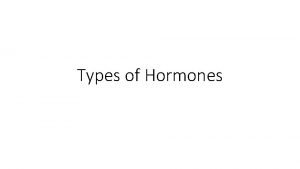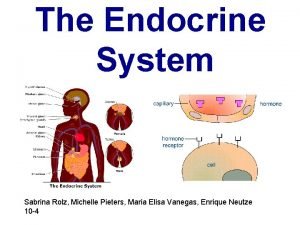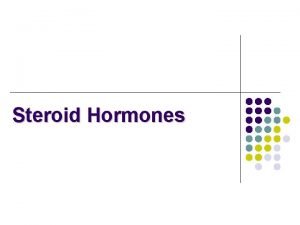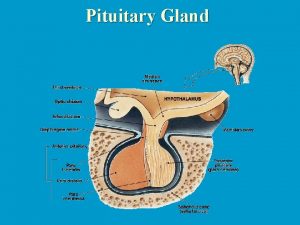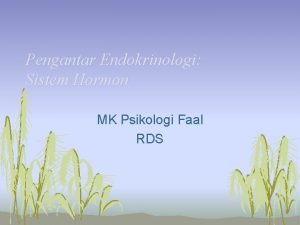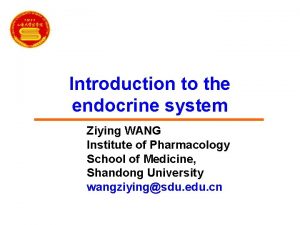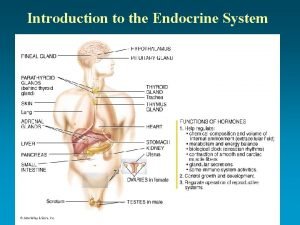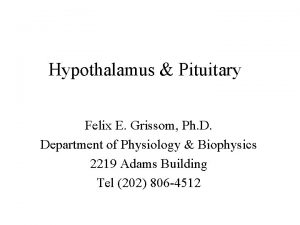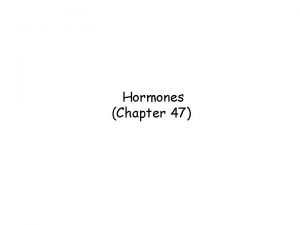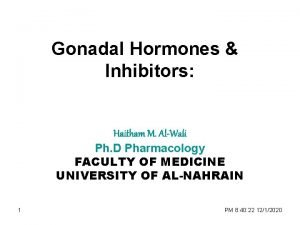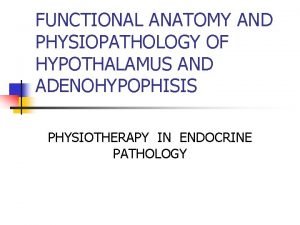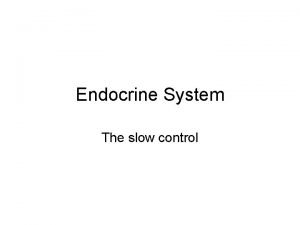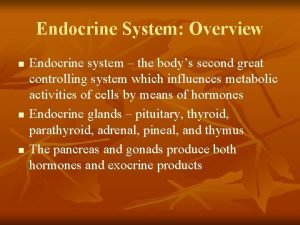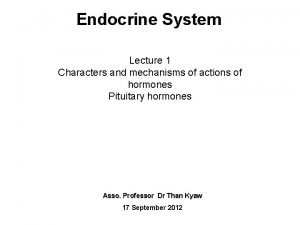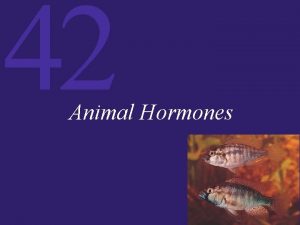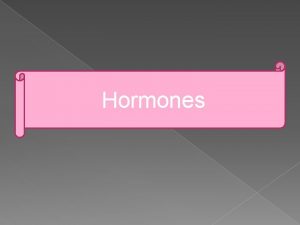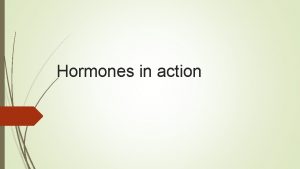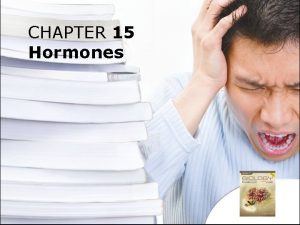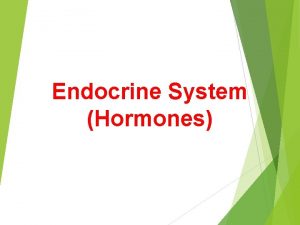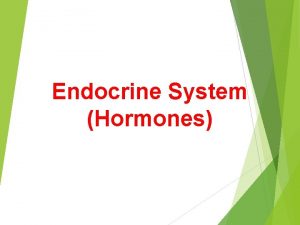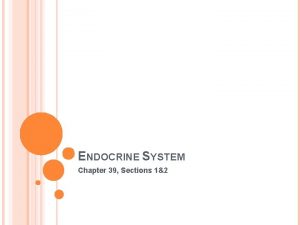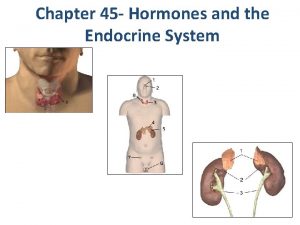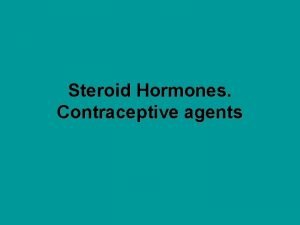Chapter 7 II Introduction to Hormones v Hormones


















- Slides: 18

Chapter 7 II. Introduction to Hormones

v. Hormones: 1. Are chemical messengers secreted by endocrine tissues 2. They alter the physiological activity of specific target cells. v. Target cells: Ø Hormones come into contact with all the tissues of the body٫ but they affect only specific cells. Ø The cells affected by a particular hormone are referred to as the target cells of that hormone. Ø They are recognized by the presence of hormone receptors on the: Ø Outside of the plasma membrane or Ø In the cytoplasm.

q There are two main types of hormones: 1. Circulating hormones 2. Local hormones 1. Circulating hormones (Endocrines) Ø Are hormones that diffuse into the blood and act on distant target cells Ø Most circulating hormones are synthesized and secreted by specialized epithelial cells (endocrine) located in structures called endocrine glands.

Ø Some endocrine cells are not found in: Ø Structures limited to the production of hormones. Ø For example: 1) Enteroendocrine cells: a. Are scattered among other epithelial cells that line the digestive tract b. They secrete hormones involved in the digestive process. 2) Neurohormones: a. Hormones secreted by neurons are called neurohormones b. Are secreted by cells in the hypothalamus

2)Local Hormones: A)Paracrines Hormones: ü Are chemical messengers that act on nearby cells ü An example is histamine: 1. which is released by: i) Mast cells and ii) Damaged tissue cells 2. It acts on nearby blood vessels, causing them to dilate.

B) Autocrines Hormones: § Autocrines are chemical messengers § Act on the same cells that secreted them. § An example is interleukin-2 (IL-2):

Endocrine glands is a structure whose primary function is to secrete hormones Major endocrine glands are: 1. Adrenal gland 2. Parathyroid glands 3. Pinal gland 4. Pituitary gland 5. Thymus 6. Thyroid gland

Structures that contain Endocrine Tissue: Many structures of the body contain endocrine tissue (cells that secrete hormones), but they have other functions as well. These include: 1) Heart 8) Skin 2) Hypothalamus 9) Small Intestine 3) Kidneys 10) Stomach 4) Liver 11) Testes 5) Ovaries 6) Pancreas 7) Placenta

Chemistry of Hormones n There are four principal classes of hormones: Steroids 2) Biogenic amines 3) Peptides and proteins 4) Eicosanoids 1)

1) Steroids n n n Steroids are a class of lipids thus; they are fat-soluble and can pass through plasma membranes by diffusion. Being water-insoluble, they circulate in the blood bound to plasma proteins. They are all derived from cholesterol.

n n n Steroids hormones are synthesized by the adrenal cortex, the gonads, and the placenta. The adrenal cortex secretes 1. Glucocorticoids: cortisol 2. Mineralocorticoids: aldosterone The ovaries secrete 1. Estrogens 2. Progesterone The testes secrete: 1. Testosterone

n n Calcitriol (1, 25 -dihydroxy vitamin D 3; the active form of vitamin D) n Is produced by a series of reactions that start in the skin in response to stimulation by ultraviolet light n the final reaction occur the in liver and kidneys. Glucocorticoids: mainly Cortisol (also cortisone and corticosterone). Mineralocorticoids: mainly Aldosterone. Sex Hormones: Estrogen, progesterone, and Testosterone.

(2) Biogenic Amines n n n Small Water-soluble compounds derived from amino acids. Hormones of this chemical type include the: 1. Thyroid hormones 2. Catecholamines 3. Histamine (a local hormone). The thyroid hormones and catecholamines are derived from the amino acid tyrosine. Histamine is derived from the amino acid histidine. Structurally, these are the simplest hormone molecules.

1)Thyroid Hormones: a) Triiodothyronine (T 3) b) Thyroxine (T 4). 2)Catechholamines: a) Epinephrine b) Norepinphrine 3)Histamine.

(4) Eicosanoids n n n Eicosanoids are derived from the 20 -carbon fatty acid. They are synthesized by all cells of the body The two major types of eicosanoids are: n Prostaglandins. n Leukotrienes.

Hormone receptors Ligands and Receptors Ligand are any ion or molecule that binds to a receptor protein by forces other then covalent bonds. All chemical messengers (circulating hormones, local hormones, second messengers, and neurotransmitters) are ligands. Ø Receptors A receptor is a protein molecule that has a binding site for a chemical messenger. Ø

1 - Binding sites Is a region of the protein that has a shape that is complementary to that of the chemical messenger This property of a binding site is referred to as chemical specificity. The binding site also has charged and polarized regions that interact electrically with the ligand. The term affinity refers to how strongly a ligand is held to a binding site

2 - Target Cell Recognition: Some binding sites are specific for only one type of chemical messenger. This allows a chemical messenger to “identify” a particular protein receptor On the outer surface of a particular type of cell In the cytoplasm of a particular type of cell. In this way a hormone can “recognize” its target cells.
 Oxication
Oxication Nontropic hormones
Nontropic hormones Types of hormones
Types of hormones Amino acid derivative hormones
Amino acid derivative hormones Action of steroid hormones
Action of steroid hormones Plant biology ppt
Plant biology ppt Oxytocin
Oxytocin Kelenjar dan hormon
Kelenjar dan hormon Transportation of hormones
Transportation of hormones Lipid soluble hormones examples
Lipid soluble hormones examples Hypothalamus hormones
Hypothalamus hormones Lipid soluble hormone
Lipid soluble hormone Lipid soluble hormones examples
Lipid soluble hormones examples Gonadal hormones
Gonadal hormones Hypothalamic hormones
Hypothalamic hormones Bioflix activity homeostasis low blood glucose
Bioflix activity homeostasis low blood glucose What is a tropic hormone
What is a tropic hormone Amino acid-based hormones
Amino acid-based hormones Hypothalmus
Hypothalmus


